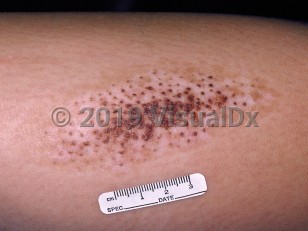Speckled lentiginous nevus in Child
Alerts and Notices
Important News & Links
Synopsis

Nevus spilus, or speckled lentiginous nevus, is a melanocytic lesion composed of small, dark macules (nevus spilus maculosus) or macules and papules (nevus spilus papulosis) within a larger but more lightly pigmented patch. Some consider these lesions to be subtypes of congenital melanocytic nevi. The macules or papules within the background patch are nevi, typically junctional or compound, and less often blue or Spitz nevi. The pathogenesis is thought to be related to a local defect in neural crest melanoblasts, and mosaic-activating mutations in PTPN11 have been identified in 3 patients with large or segmental nevus spilus.
Nevus spilus can be associated with a number of other conditions and findings, including but not limited to corneal dystrophy, scleral pigmentation, hearing loss, Ebstein anomaly, ichthyosis, neurofibromatosis type 1, epidermal nevi, and a nevus sebaceus. Nevus spilus is a component of certain subtypes of phakomatosis pigmentovascularis. The speckled lentiginous nevus syndrome is the rarely occurring association of a nevus spilus (usually nevus spilus papulosis) and neuromuscular abnormalities, including a sensory or motor neuropathy and hyperhidrosis. Onset of the neurologic abnormalities is typically in adulthood, but childhood onset has been reported.
Nevus spilus shows no predilection for either sex but is slightly more common in individuals of Northern European descent than in other ethnicities. Most lesions are present at birth or become evident during the first year of life. They are benign lesions with a rare incidence of malignant transformation. Risk of melanoma development appears to correlate with lesions greater than 4 cm, zosteriform or segmental subtypes, and lesions present at birth. In addition, a particular mosaic mutation of PTPN11 was found to be correlated with the development of melanoma within a large segmental nevus spilus.
Nevus spilus can be associated with a number of other conditions and findings, including but not limited to corneal dystrophy, scleral pigmentation, hearing loss, Ebstein anomaly, ichthyosis, neurofibromatosis type 1, epidermal nevi, and a nevus sebaceus. Nevus spilus is a component of certain subtypes of phakomatosis pigmentovascularis. The speckled lentiginous nevus syndrome is the rarely occurring association of a nevus spilus (usually nevus spilus papulosis) and neuromuscular abnormalities, including a sensory or motor neuropathy and hyperhidrosis. Onset of the neurologic abnormalities is typically in adulthood, but childhood onset has been reported.
Nevus spilus shows no predilection for either sex but is slightly more common in individuals of Northern European descent than in other ethnicities. Most lesions are present at birth or become evident during the first year of life. They are benign lesions with a rare incidence of malignant transformation. Risk of melanoma development appears to correlate with lesions greater than 4 cm, zosteriform or segmental subtypes, and lesions present at birth. In addition, a particular mosaic mutation of PTPN11 was found to be correlated with the development of melanoma within a large segmental nevus spilus.
Codes
ICD10CM:
D22.9 – Melanocytic nevi, unspecified
I78.1 – Nevus, non-neoplastic
SNOMEDCT:
398660000 – Nevus spilus
D22.9 – Melanocytic nevi, unspecified
I78.1 – Nevus, non-neoplastic
SNOMEDCT:
398660000 – Nevus spilus
Look For
Subscription Required
Diagnostic Pearls
Subscription Required
Differential Diagnosis & Pitfalls

To perform a comparison, select diagnoses from the classic differential
Subscription Required
Best Tests
Subscription Required
Management Pearls
Subscription Required
Therapy
Subscription Required
References
Subscription Required
Last Reviewed:07/25/2023
Last Updated:07/26/2023
Last Updated:07/26/2023
 Patient Information for Speckled lentiginous nevus in Child
Patient Information for Speckled lentiginous nevus in Child
Premium Feature
VisualDx Patient Handouts
Available in the Elite package
- Improve treatment compliance
- Reduce after-hours questions
- Increase patient engagement and satisfaction
- Written in clear, easy-to-understand language. No confusing jargon.
- Available in English and Spanish
- Print out or email directly to your patient
Upgrade Today

Speckled lentiginous nevus in Child

